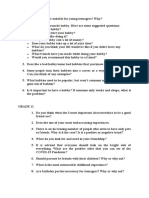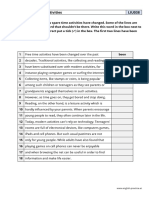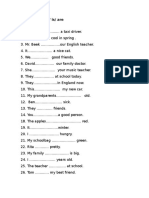Education System in The UK
Education System in The UK
Uploaded by
Rosey SanCopyright:
Available Formats
Education System in The UK
Education System in The UK
Uploaded by
Rosey SanOriginal Title
Copyright
Available Formats
Share this document
Did you find this document useful?
Is this content inappropriate?
Copyright:
Available Formats
Education System in The UK
Education System in The UK
Uploaded by
Rosey SanCopyright:
Available Formats
Edited by Miss J.
NJ
Education system in UK involved in England, Wales, Northern Ireland and Scotland.
The majority of children in the UK attend school from around 09.00 to between 15.00 and 16.00. In England and Wales, the school year generally runs from early September to the latter part of July. Schools normally operate five days a week (Monday to Friday). There is a movement to adopt a six-term school year. Several schools have already adopted this model. Schools in Northern Ireland typically operate for 200 days a year starting in early September and ending in June.
The curriculum for compulsory education in England and Wales is divided into four key stages (KS): KS1 (ages 5 to 7), KS2 (ages 7 to 11), KS3 (ages 11 to 14) and KS4 (14 to 16).
In Northern Ireland, the curriculum stages are the Foundation Stage (ages 4 to 6), KS1 (ages 6 to 8), KS3 (ages 11 to 14) and KS4 (14 to 16).
For children aged from three months to three years, provisions for preschool are largely in the private and voluntary sectors and parents pay fees. Spots are available in state maintained nursery schools and classes in primary schools, and in voluntary and private settings for children ages 3 to 5 years old. Free part-time nursery provision is now available for all three- and fouryear-olds in England and Wales, and for all children in their pre-school year in Northern Ireland whose parents want it. Children who are eligible for free provision are usually entitled to attend five two-and-a-half hour sessions per week for 38 weeks a year.
Primary school begins between the age of 4 and 5 for most students, depending on the childs birthday. Students generally remain at primary school for seven years. Below is a chart showing the age range and grade level for England/Wales, Northern Ireland and Scotland.
Age 5 to 11 (England/Wales) Age 4 to 11 (Northern Ireland) Age 5/6 to 11/12 (Scotland)
Age 11 to 16 (England/Wales/Northern Ireland) Age 11/12 to 15/16 (Scotland)
In Northern Ireland, secondary education begins at age 11. All students study a broad base of subjects which include Geography, English, Mathematics, Science, PE, Music and modern languages. Students at age 14 chose which subjects to continue to study for General Certificate of Secondary Education (GCSE) examinations. GCSEs mark the end of compulsory education in Northern Ireland. This chart illustrates the age range and secondary educational levels for England/Wales, Northern Ireland and Scotland. Scottish students transfer to secondary schools at age 12, a year later than elsewhere in the UK. Many students take Scottish Qualifications Certificate qualifications. Students take Standard Grades in S4 Age (Age 15/16), Highers in S5 (16/17) and S6 (17/18). For those who remain at school for the final year, more highers and Advanced Highers in S6.
The General Certificate of Secondary Education (GCSE) is an academic qualification awarded in a specified subject, generally taken in a number of subjects by students aged 1416 in secondary education in England, Wales, and Northern Ireland
The Advanced Level General Certificate of Education, universally referred to as an A-level, is a qualification offered by education institutions in England, Northern Ireland and Wales and by a small minority of institutions, typically private, in Scotland.
A levels are usually studied over a two year period and are widely recognised around the world, as well as being the qualification that is the most common method used by British Universities to determine an applicant's suitability for academic subjects. A levels are part of the tertiary Further Education (FE) process in the United Kingdom. A levels can also be studied by students in the last two years (12 and 13) in a Sixth Form at secondary school. This is an integrated part of a Secondary Education institution in many areas of the country, while others have separate Sixth Form Colleges. This is normally done as a direct continuation of the secondary education process and hence most students study for the qualification from age 16 to 18.
The end
You might also like
- Tip Module 4 AnswersDocument21 pagesTip Module 4 AnswersEstrelita B. Santiago81% (93)
- 3 Research Proposal - Jimenez, Mary Grace P.Document13 pages3 Research Proposal - Jimenez, Mary Grace P.Mary Grace Jimenez100% (3)
- Essays KaistDocument2 pagesEssays KaistMiriam AkinsNo ratings yet
- Bristol's Marking Criteria For Translation From EnglishDocument1 pageBristol's Marking Criteria For Translation From EnglishBlue FlameNo ratings yet
- Practice Test Academic ReadingDocument14 pagesPractice Test Academic ReadingSenuja Pasanjith100% (1)
- Lesson - Plan - 3rd GradeDocument4 pagesLesson - Plan - 3rd GradeDana Maria Motfolea0% (1)
- RoadtoIELTS ListeningDocument11 pagesRoadtoIELTS ListeningHà Hồng Nhung100% (1)
- Clasa A X-A - Scoala - 2014-2015 Subiect&BaremDocument4 pagesClasa A X-A - Scoala - 2014-2015 Subiect&BaremFlorinela PopaNo ratings yet
- 1cambrigton Dave Ielts Reading 100 9 PointsDocument43 pages1cambrigton Dave Ielts Reading 100 9 PointsWit FksunNo ratings yet
- Ae 04Document8 pagesAe 04arun5918No ratings yet
- The British Education SystemDocument4 pagesThe British Education SystemOana DuricanNo ratings yet
- Cloze Test and DictationDocument2 pagesCloze Test and DictationAlexNo ratings yet
- Ebook - 8 Principles New CoverDocument32 pagesEbook - 8 Principles New CoverShwe Yee HtooNo ratings yet
- LESSON PLAN Blockbuster 1 - StorytimeDocument4 pagesLESSON PLAN Blockbuster 1 - StorytimeRadu NanNo ratings yet
- Speaking TopicsDocument2 pagesSpeaking TopicsDhāraṇe KusalaNo ratings yet
- The Education System in England and Wales IsnDocument1 pageThe Education System in England and Wales IsnJamillaAllimajDumbuyaNo ratings yet
- Grammatical Structures 4th Grade (YLE Movers)Document4 pagesGrammatical Structures 4th Grade (YLE Movers)Andreea-Raluca ManeaNo ratings yet
- Language Is Primarily An Auditory System of SymbolsDocument6 pagesLanguage Is Primarily An Auditory System of SymbolsDomingos Tolentino Saide DtsNo ratings yet
- PTEYL Guide FirstwordsDocument30 pagesPTEYL Guide FirstwordsgennoffNo ratings yet
- Women in Science WorksheetDocument2 pagesWomen in Science WorksheetJanna RickNo ratings yet
- B Bacalaureat 2008 Limba Engleza L1 Normal Si L2Document3 pagesB Bacalaureat 2008 Limba Engleza L1 Normal Si L2Mircea EuNo ratings yet
- Providing Education IELTS Essay Band 7.5Document2 pagesProviding Education IELTS Essay Band 7.5Bhanu Kumar ShakyaNo ratings yet
- A2 KEY Front MatterDocument3 pagesA2 KEY Front Matterayemyatkhaing.designNo ratings yet
- Teacher Training Course: ICQ Instruction Checking QuestionsDocument27 pagesTeacher Training Course: ICQ Instruction Checking QuestionsJANAINA QUEIROGANo ratings yet
- IELTS Exams CollectionDocument18 pagesIELTS Exams CollectionAgatha Tanti100% (1)
- Education in England: Gheorghiu Costel Judele Dragos Burghelea AlexandruDocument7 pagesEducation in England: Gheorghiu Costel Judele Dragos Burghelea AlexandruCostelGheorghiuNo ratings yet
- New FCE Gold - Teacher S Book Unit 3Document8 pagesNew FCE Gold - Teacher S Book Unit 3JulianaNo ratings yet
- Christianity: The Partnership of Church and StateDocument2 pagesChristianity: The Partnership of Church and Statemelanie aguirreNo ratings yet
- English Vocabulary Teaching in Chinese Junior High SchoolsDocument63 pagesEnglish Vocabulary Teaching in Chinese Junior High Schoolssahani thenuwaraNo ratings yet
- Listening - Test 1Document4 pagesListening - Test 1Trương Mỹ ViNo ratings yet
- Cambridge Instructions To CandidatesDocument3 pagesCambridge Instructions To CandidatesMrTechnomasterNo ratings yet
- B2 Free Time Activities LIU038: WWW - English-Practice - atDocument2 pagesB2 Free Time Activities LIU038: WWW - English-Practice - atIrma GochaleishviliNo ratings yet
- Starlight 10 Teacher's BookDocument112 pagesStarlight 10 Teacher's Bookполина ты ктоNo ratings yet
- Use of Technology in English Language Teaching and LearningDocument1 pageUse of Technology in English Language Teaching and LearningBruno ForgiariniNo ratings yet
- Evaluation Questionnaire 2nd Ltta in CroatiaDocument3 pagesEvaluation Questionnaire 2nd Ltta in Croatiaapi-536798661No ratings yet
- Ielts Test 5Document12 pagesIelts Test 5Nancy West44% (9)
- New Ways in English For Specific PurposesDocument5 pagesNew Ways in English For Specific PurposesKleyton PereiraNo ratings yet
- 2019 Dictation Class Teacher's GuideDocument96 pages2019 Dictation Class Teacher's GuideDiệuMinhNo ratings yet
- The Assessment Scales: B1 Content Communicative Achievement Organisation Language 5Document1 pageThe Assessment Scales: B1 Content Communicative Achievement Organisation Language 5jkllNo ratings yet
- Lesson Plan ArticleDocument5 pagesLesson Plan ArticleelenajillNo ratings yet
- Reading Comprehension - First CertificateDocument5 pagesReading Comprehension - First Certificatecorazon_salvaje100% (1)
- Individual English Contest PDFDocument1 pageIndividual English Contest PDFgangaraju0% (1)
- Excersices Verb To BeDocument1 pageExcersices Verb To BeMili ReyNo ratings yet
- British Culture - QuizDocument2 pagesBritish Culture - QuizMartin SketchleyNo ratings yet
- IELTS OverviewDocument6 pagesIELTS OverviewKim HyungNo ratings yet
- English Debate Script: "The Impact of Social Networking For Students"Document5 pagesEnglish Debate Script: "The Impact of Social Networking For Students"Arlan TogononNo ratings yet
- Four Types of TestsDocument2 pagesFour Types of Testssupyae moNo ratings yet
- Mission 2 Planificare CalendaristicaDocument5 pagesMission 2 Planificare Calendaristicamirela_ema74No ratings yet
- Michelangelo Lesson PlanDocument4 pagesMichelangelo Lesson Planapi-336040432No ratings yet
- The Significant Role of Mother Tongue in EducationDocument3 pagesThe Significant Role of Mother Tongue in EducationThảo NguyễnNo ratings yet
- Masterclass For Ielts TrainersDocument2 pagesMasterclass For Ielts TrainersManojNo ratings yet
- Ah Lesson Plan Magic Pot 1Document11 pagesAh Lesson Plan Magic Pot 1Achu Iedah100% (2)
- Grade 4 Reading Comprehension (New Set)Document3 pagesGrade 4 Reading Comprehension (New Set)Errl JerrolNo ratings yet
- Christmas Close Exercise PDFDocument1 pageChristmas Close Exercise PDFEmily SichNo ratings yet
- School Magazine With Contents PageDocument2 pagesSchool Magazine With Contents PageMichael SiscarNo ratings yet
- Messages L1 PED Scheme of Work Part 1Document15 pagesMessages L1 PED Scheme of Work Part 1Ismet EminiNo ratings yet
- Ielts Speaking TestDocument3 pagesIelts Speaking TestThanh Ngân Lưu HoàngNo ratings yet
- England: The Uk Education SystemDocument13 pagesEngland: The Uk Education SystempedroNo ratings yet
- UK School System: Terminology DifferencesDocument8 pagesUK School System: Terminology DifferencesJoseph LizadaNo ratings yet
- Education System in The UKDocument6 pagesEducation System in The UKPiroska SzolnokiNo ratings yet
- Limba Engleza Nivel Incepator: STUDENT: Stroe IuliaDocument21 pagesLimba Engleza Nivel Incepator: STUDENT: Stroe IuliaIulia StroeNo ratings yet
- British Education SystemDocument12 pagesBritish Education SystemAnastasija KursukaiteNo ratings yet
- TSL 3113 Modul Complete BiDocument106 pagesTSL 3113 Modul Complete BiRosey SanNo ratings yet
- WRITING 1 Approaches To The Teaching of Writing 12.JRDocument37 pagesWRITING 1 Approaches To The Teaching of Writing 12.JRRosey San100% (1)
- Meaningful Learning and The EFL/ESL ClassroomDocument6 pagesMeaningful Learning and The EFL/ESL ClassroomRosey SanNo ratings yet
- The Jungle BookDocument28 pagesThe Jungle BookRosey SanNo ratings yet
- Week 8, Icarus 2Document14 pagesWeek 8, Icarus 2Rosey SanNo ratings yet
- Final Industrial Attachment ReportDocument21 pagesFinal Industrial Attachment ReportJulius Juju Kenango100% (1)
- University of Cambridge International Examinations International General Certificate of Secondary EducationDocument4 pagesUniversity of Cambridge International Examinations International General Certificate of Secondary EducationADITYA NAVARENo ratings yet
- Test Results: For Questions 1-9, Read The Text Below and Decide Which Answer (A, B, C or D) Best Fits Each GapDocument14 pagesTest Results: For Questions 1-9, Read The Text Below and Decide Which Answer (A, B, C or D) Best Fits Each GapVu Linh DangNo ratings yet
- Review of Related LiteratureDocument8 pagesReview of Related LiteratureNORZEN LAGURANo ratings yet
- CePIETSO PCP Brochure 2020Document4 pagesCePIETSO PCP Brochure 2020Corona VirusNo ratings yet
- Camarines Norte - 0 PDFDocument290 pagesCamarines Norte - 0 PDFMauNo ratings yet
- DBMS Mini ProjectDocument7 pagesDBMS Mini Project1DT20IS083 Samarth NNo ratings yet
- Lesson Plan Fruits and Vegetables 1er GradoDocument8 pagesLesson Plan Fruits and Vegetables 1er GradomarluzmaresNo ratings yet
- M8 Q1W1D4 Contextualized-LP1Document3 pagesM8 Q1W1D4 Contextualized-LP1John Ray MacaspagNo ratings yet
- Curriculum VitaeDocument4 pagesCurriculum Vitaeapi-346220114No ratings yet
- Translation, Gender and OthernessDocument9 pagesTranslation, Gender and OthernessJanet LeeNo ratings yet
- Interviewing SkillsDocument5 pagesInterviewing SkillsRadu TodoranNo ratings yet
- Hispania 100.5 2017 With Cover Page v2Document348 pagesHispania 100.5 2017 With Cover Page v2Michael SmithNo ratings yet
- Ebdog: National School Delivery Cost BenchmarkingDocument33 pagesEbdog: National School Delivery Cost BenchmarkingasismondNo ratings yet
- Yr 12 Assessment Task BiologyDocument12 pagesYr 12 Assessment Task Biologyapi-357683310No ratings yet
- التقييم المعتمد على المعايير في الجامعاتDocument40 pagesالتقييم المعتمد على المعايير في الجامعاتQaidNo ratings yet
- Professional Education Part 2Document4 pagesProfessional Education Part 2Jessel IbrahimNo ratings yet
- Egmp 29.Document4 pagesEgmp 29.Vion VionNo ratings yet
- Virtue EthicsDocument2 pagesVirtue EthicsShaila Ivory100% (1)
- DLL Grade 8 Sciemce Week 1Document3 pagesDLL Grade 8 Sciemce Week 1Kristine KarenNo ratings yet
- Valdes Ramsey ResumeDocument1 pageValdes Ramsey Resumeapi-435364922No ratings yet
- Ap-300S: Solutions To Quizzer On Financing, Expenditure/Purchase & Disbursement Cycles: Audit of LiabilitiesDocument9 pagesAp-300S: Solutions To Quizzer On Financing, Expenditure/Purchase & Disbursement Cycles: Audit of Liabilitiesryan rosalesNo ratings yet
- AnthropologyDocument19 pagesAnthropologyRam Surya Prakash ReddyNo ratings yet
- Ray Optics Short Notes From Swayam (AIR 8 NEET 2023)Document4 pagesRay Optics Short Notes From Swayam (AIR 8 NEET 2023)Himanshu PuriNo ratings yet
- Thesis On Feedback in EducationDocument4 pagesThesis On Feedback in Educationangelagibbsdurham100% (2)
- Latest Deped Orders Session-GuideDocument1 pageLatest Deped Orders Session-GuideAnna Marie Augusto CuyosNo ratings yet
- Effectiveness of A Handwriting Readiness Program in Head Start: A Two-Group Controlled TrialDocument9 pagesEffectiveness of A Handwriting Readiness Program in Head Start: A Two-Group Controlled TrialLena CoradinhoNo ratings yet
- Managing CrisisDocument215 pagesManaging CrisisZafar NawazNo ratings yet






























































































